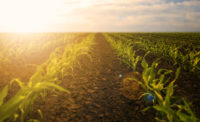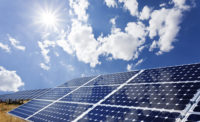Research project improves renewable electric energy on dairy farms
The goal is to raise renewable electric energy generation on dairy farms by establishing a “net-zero” energy milking parlor.

The typical dairy uses a large amount of energy, especially during milking. This stems from milking frequency, cooling milk and cleaning equipment with hot water. Renewable energy systems generally become more economically efficient as energy demands rise, making farms a great place to incorporate renewable energy.
However, dairy farms have not typically been set up with energy efficiency in mind, and often use relatively expensive fuel sources like heating oil or propane to heat water. One of the difficulties with renewable energy systems is the intermittent generation of wind and solar energy, whereas the energy load on a dairy farm is very consistent since cows are milked two or three times every day.
That’s why the team at the University of Minnesota West Central Research and Outreach Center (WCROC), Morris, Minn., created a goal in 2013 to raise renewable electric energy generation on dairy farms by establishing a “net-zero” energy milking parlor.
The WCROC team has been monitoring water and energy usage since the fall of 2013. The Morris dairy operation milks between 200-270 cows twice daily, and is representative of a mid-size Minnesota dairy farm. The cows are split almost evenly between a conventional and a certified organic grazing herd, and all cows spend the winter outside in lots near the milking parlor.
The existing dairy equipment reflected similarly sized dairy farms, but included none of the commonly recommended energy efficiency enhancements such as a plate cooler, refrigeration heat recovery or variable frequency drives (VFDs) for pump motors.
The project entailed installing a data logger in the utility room of the milking parlor in August 2013 and monitored 18 individual electric loads, 12 water flow rates, 13 water temperatures and two air temperatures. Average values have been recorded every 10 minutes for the last 2.5 years. The milking parlor boasts gas and electric meters that measure the total consumption of natural gas and electricity within the parlor.
The data helped evaluate energy and water usage of various milking appliances. Some small energy loads were not measured in unused parts of the barn, or were not directly related to the milking operation. These loads fall into miscellaneous categories and are estimated by subtracting all the measured energy use.
Where does the energy go?
Overall, the milking parlor currently consumes about 250-400 kWh in electricity and uses between 1,300- 1,500 gallons of water per day. The parlor currently uses about 110,000 kWh per year (440 kWh per cow per day) in electricity and 4,500 therms per year in natural gas. A majority of the electricity used is for cooling milk (27%), followed by ventilation and fans (16%).
WCROC’s dairy uses about 600 gallons of hot water per day, with a majority used for cleaning and sanitizing milking equipment, followed closely by cleaning the milking parlor. Energy and water usage fluctuates throughout the year because the dairy calves 60% of its cows from March to May and 40% from September to December. Therefore, water and energy use escalates dramatically during April.
The project’s first energy efficiency upgrade was a variable frequency drive for the vacuum pump. Before the upgrade, the vacuum pump used 55-65 kWh per day. After the September 2013 installation, the vacuum pump used 12 kWh per day, a 75% reduction in energy usage. The data show a large drop in daily electricity usage by the pump, providing a vivid example of the kind of energy savings that can be achieved with relatively simple upgrades.
Furthermore, because of the dairy’s organic and conventional systems, it features two bulk tank compressors—one scroll and one reciprocating. The scroll compressor is the newest and uses 15 kWh per day vs 40 kWh per day for the reciprocating compressor.
In terms of fossil energy use, milk harvesting consumed more energy than feeding and maintenance. This suggests that fossil energy use per unit of milk could be greatly reduced by replacing older equipment with new, more efficient technology or substituting renewable sources of energy into the milk harvesting process.
Becoming more energy efficient
To improve energy efficiency, begin with an audit to gather data and identify energy saving opportunities. Some energy efficiency options that may be installed on dairy farms include refrigeration heat recovery, VFDs, plate coolers and more efficient lighting and fans. A majority of these upgrades have immediate to 2- to 5-year paybacks.
Make all electrical loads as efficient as possible, yet practical. Consider converting all thermal loads to electricity by the use of heat pumps that allow for cooling of milk. The project entails future plans to harvest energy from the dairy’s manure lagoon and store electricity as heat by use of heat pumps.
Renewable energy options also can improve energy efficiency. These include solar thermal collectors to preheat water, solar photovoltaic panels for generating electricity, small-scale wind turbines for electricity and large insulated tanks for thermal energy storage.
During the summer, the team will install a 50 kW DC ground mount solar photovoltaic array and two 10 kW wind turbines to meet the dairy’s energy demands. A 2,200 thermal
storage system employing an electric heat pump will also be installed to recover heat from the milk refrigeration system and solar thermal collectors. The “greening” of the dairy energy project will investigate energy storage technology that could significantly improve the feasibility of renewable energy on farms in the future.
Looking for a reprint of this article?
From high-res PDFs to custom plaques, order your copy today!





